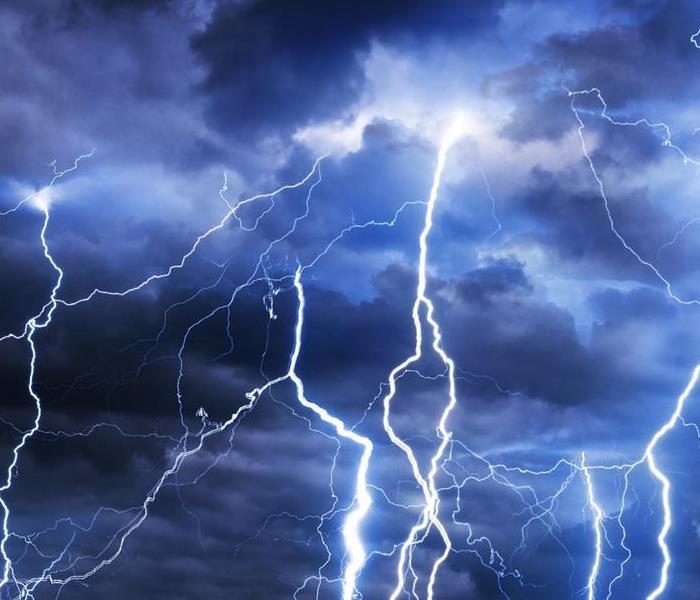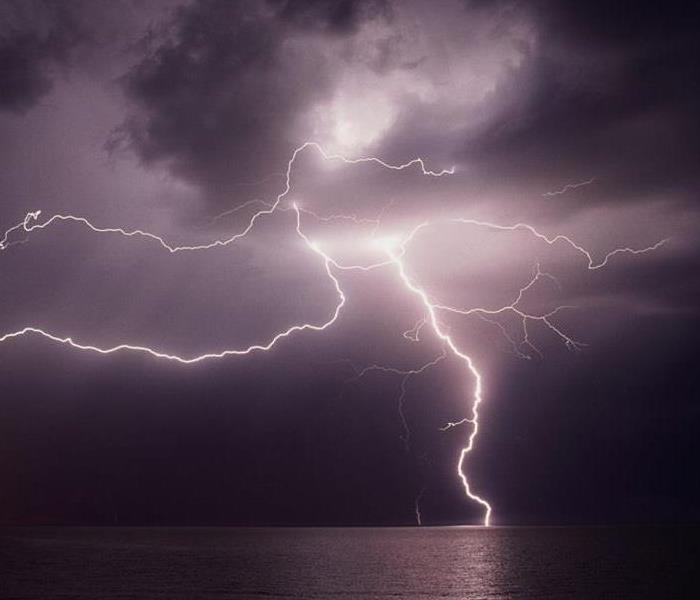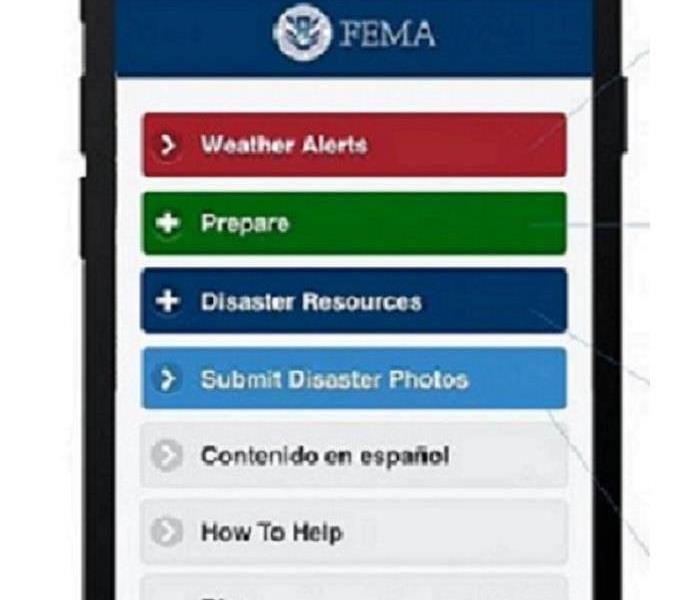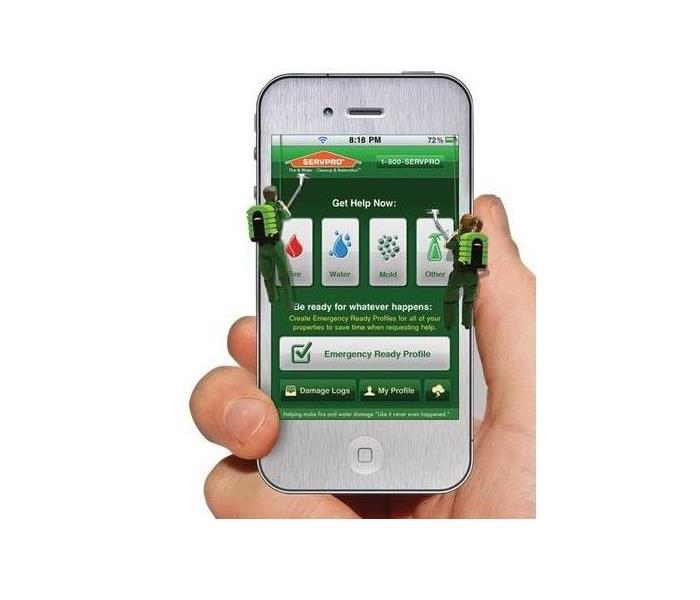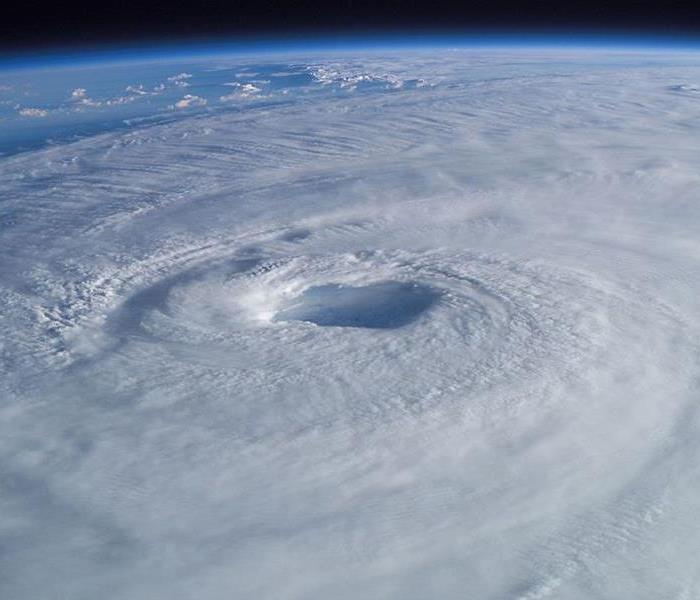Archived Storm Damage Blog Posts
September 10th--Peak Hurricane Season
9/12/2024 (Permalink)
The peak of the Atlantic hurricane season is September 10th, with most activity occurring between mid-August and mid-October, according to the National Oceanic and Atmospheric Administration.
According to the NOAA, the exact day of September 10th is the day you are mostly likely to find a tropical cyclone somewhere in the Atlantic, statistically speaking. This year, the peak of Hurricane Season coincided with Hurricane Francine in the Gulf of Mexico.
Do not wait to prepare yourself for a hurricane when a storm forms in the Atlantic and stores are filling with shoppers looking for emergency supplies.
There are steps that you can take now to ensure you and your household are more prepared for the peak hurricane season:
- Build a survival kit. You and your household should be prepared to shelter in a secure and safe location for several days after a disaster when roads may be impassable, gas stations and grocery stores closed, power and communications being out. Common items are water—drinking and sanitation, food, medication, first aid kit and hygiene products.
- Make a Family Communication Plan. Choose an out-of-town friend or relative as a point of contact. Make sure children have emergency contacts memorized or saved in a secure place. Determine a safe, familiar place the family can go to reunite.
- Stay Informed. Listen to local officials for the most up-to-date information before, during and after a disaster. Keeping a battery or solar-powered radio to receive disaster notices and updates in your survival kit is key.
2024 Hurricane Season
5/24/2024 (Permalink)
NOAA National Weather Service forecasters are predicting an above-normal hurricane activity this year. The 2024 Hurricane Season spans from June 1st to November 30th. NOAA is forecasting a range of 17-25 total named storms (winds of 39 mph or higher). Out of those, 8-13 are forecast to become hurricanes with winds of 74 mph or higher and that includes 4 to 7 major hurricanes (cat 3, 4, 5).
FEMA in accordance with NOAA is recommending going ahead and preparing because severe weather and emergencies can happen at any moment. Taking a proactive approach today can make a difference in how quickly people can recover tomorrow.
NOAA is taking multiple steps to ensure better communications for the 2024 season.
- NOAA is implementing improvements to its forecast communications, decision support and storm recovery efforts this season.
- They are using new tools for hurricane analysis and forecasting.
- Upgrades to NOAA observing systems that are critical in understanding and forecasting hurricanes.
For more information on the 2024 hurricane season, visit www.noaa.gov.
Prepare Now for the Peak of Hurricane Season
8/28/2023 (Permalink)
The peak of the Atlantic hurricane season is September 10th, with most activity occurring between mid-August and mid-October, according to the National Oceanic and Atmospheric Administration. Do not wait to prepare yourself for a hurricane when a storm forms in the Atlantic and stores are filling with shoppers looking for emergency supplies.
There are steps that you can take now to ensure you and your household are more prepared for the peak hurricane season:
- Build a survival kit. You and your household should be prepared to shelter in a secure and safe location for several days after a disaster when roads may be impassable, gas stations and grocery stores closed, power and communications being out. Common items are water—drinking and sanitation, food, medication, first aid kit and hygiene products.
- Make a Family Communication Plan. Choose an out-of-town friend or relative as a point of contact. Make sure children have emergency contacts memorized or saved in a secure place. Determine a safe, familiar place the family can go to reunite.
- Stay Informed. Listen to local officials for the most up-to-date information before, during and after a disaster. Keeping a battery or solar-powered radio to receive disaster notices and updates in your survival kit is key.
NOAA on 2023 Hurricane Season
5/22/2023 (Permalink)
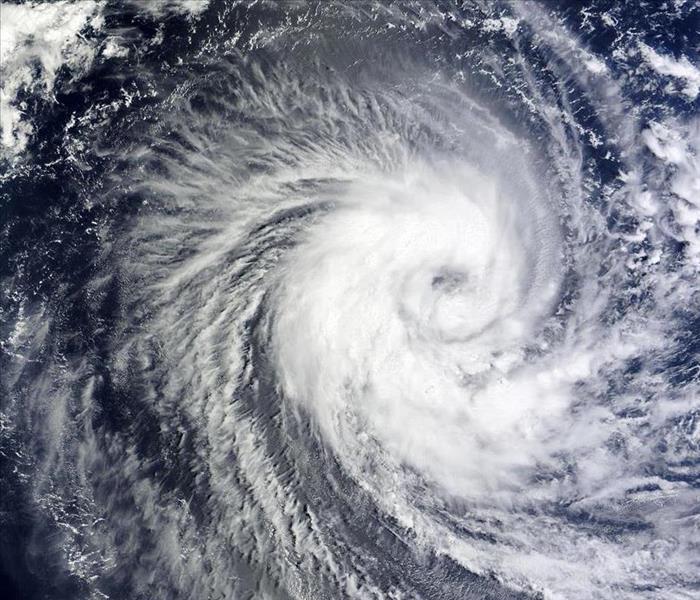 2023 Hurricane Season begins June 1st.
2023 Hurricane Season begins June 1st.
The National Oceanic and Atmospheric Administration is scheduled to issue its outlook for the 2023 Atlantic Hurricane season. The NOAA will discuss the expected number of storms and climate factors that will influence hurricane development. They will also provide advice on how to prepare for the upcoming hurricane season which officially begins on June 1st. The NOAA will also discuss their readiness for the season showcasing new products and upgrades to enhance forecasting and operations.
Hurricane names for the 2023 season have been released. There are new names in the rotation that will replace Harvey, Irma, Maria, and Nate. Those names will be replaced with Harold, Idalia, Margot, and Nigel.
Don’t forget to tune in on Thursday, May 25 to hear all about the 2023 Atlantic Hurricane Season!
3 Ways to Protect Your Home During a Flood
12/5/2022 (Permalink)
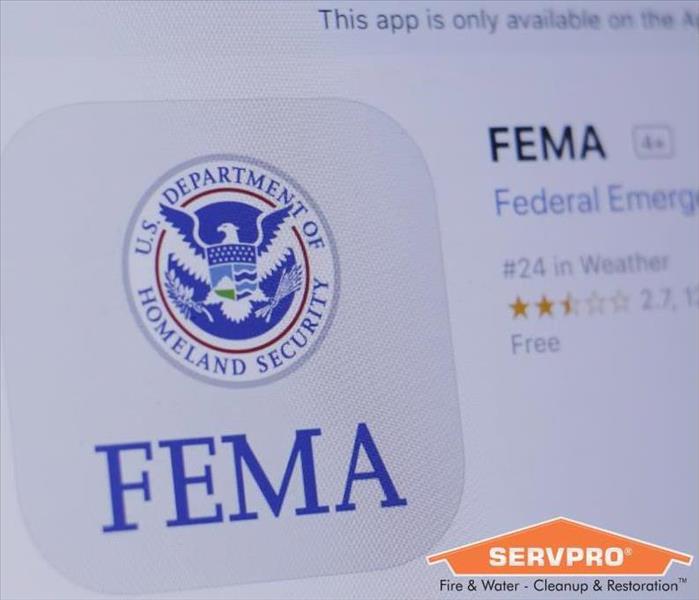 FEMA will assist with recovery and rebuilding efforts, there are things that you can do before and after a flood to help protect your property.
FEMA will assist with recovery and rebuilding efforts, there are things that you can do before and after a flood to help protect your property.
3 Ways to Protect Your Home During a Flood
Floods can happen at any time, and it's important to be prepared for them. If you live in an area that's prone to flooding, there are a few things you can do before a flood strikes so that you're ready when it does.
Seal any cracks in your home’s foundation.
After you've assessed the damage, it's time to patch the cracks in your foundation. You'll need a waterproof sealant like caulking or silicone sealant for this job. If you have silicone-based paint, use that instead of a separate caulking product because it can also be used as an adhesive for other materials like wood and metal.
First, apply the sealant to both sides of the crack, then smooth out any excess with a putty knife. Make sure you get all around the edges so there aren't any gaps where water could eventually seep through and damage your home again.
Maintain drainage areas.
- Maintain drainage areas
- Grass should be trimmed short to avoid clogging gutters, and trees and shrubs should be trimmed to ensure that water flows away from the house.
- Make sure your gutters are clean and free of debris.
- Keep downspouts clear of leaves and other debris so water can drain properly into the ground rather than pooling around your foundation or flowing toward your basement.
- Clean out rain barrels, which collect rainwater that then drains into soil rather than running off toward storm drains or sewers (and possibly flooding).
Install a sump pump.
If your home is in a flood zone, you should consider installing a sump pump. Sump pumps are used to remove excess water from the lowest part of your basement or crawl space and safely discharge it away from the house. You can also find sump pumps that feature battery backup units (BBUs) and remote monitoring technologies—these will allow homeowners to check on their sump pump remotely in case there's ever a problem with it.
If you live near a body of water or have experienced flooding at some point, consider installing this essential piece of equipment today!
Know what to do before, during, and after a flood.
The best way to protect your home is to be prepared. While the Federal Emergency Management Agency (FEMA) will assist with recovery and rebuilding efforts, there are things that you can do before and after a flood to help protect your property. Flood insurance differs from homeowner's insurance in several ways, so it's important to know the difference. It's also helpful to know what actions you should take before, during and after a flood occurs so that you can prepare accordingly:
Before a flood happens:
- Make sure all your homeowners' contents are insured—this includes appliances, electronics, furniture and clothes. You may have additional coverage from certain policies or other types of insurance (such as renters or car insurance).
We all want to protect our Amelia, TX homes, and there are many things you can do to do just that. As with any disaster, it's best to be prepared before it happens. But if you are still unsure about how best to prepare for a flood or other natural disaster, it's always good to know where your local emergency management office is located so that they can help answer any questions or concerns.
Does an Adjuster Need To Inspect Damage Prior to Mitigation?
8/22/2022 (Permalink)
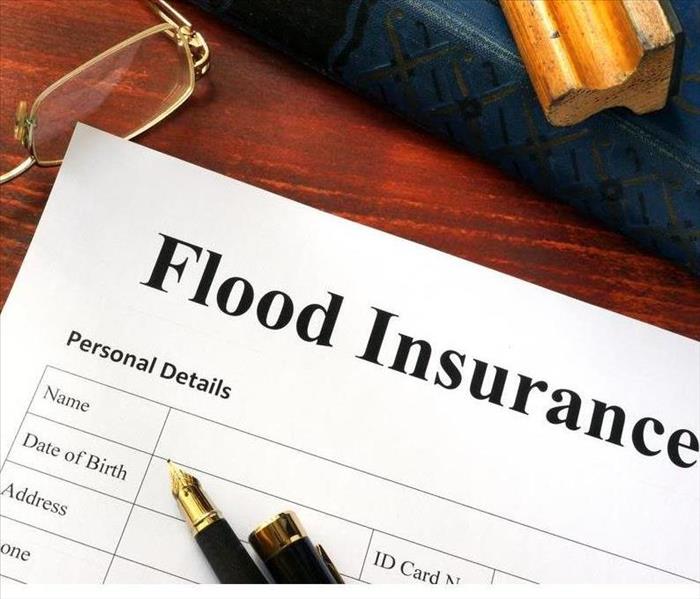 If an adjuster cannot see how bad the damage was, he or she may be less likely to settle a flood insurance claim for the full amount.
If an adjuster cannot see how bad the damage was, he or she may be less likely to settle a flood insurance claim for the full amount.
Is it necessary for an adjuster to inspect damage prior to mitigation?
Homeowners dealing with flood damage may wonder whether they should start mitigation before an adjuster arrives to assess losses. If there has recently been widespread flooding or severe weather in Beaumont, TX, adjusters may have a lengthy backlog. It can be worthwhile to mitigate damage as soon as possible. Here are a few pointers on starting mitigation for homeowners who plan to make a flood insurance claim.
Documentation Before Mitigation
A homeowner must capture the full extent of damage prior to mitigation. There are several useful forms of documentation:
• Photographs
• Video footage
• Professional estimates
This evidence will be necessary to support a flood insurance claim. Even if mitigation is underway when an adjuster arrives, proof of damage enables homeowners to obtain compensation for losses.
Provide Insurers With an Estimate
A professional estimate is also useful for making a claim. A one-stop damage mitigation and restoration company can provide a complete estimate. Insurers are more likely to accept an estimate calculated by a preferred vendor.
Schedule a Visit From an Adjuster
An adjuster will probably need to visit the property to process a claim. Homeowners should provide documentation and explain mitigation measures. Insurers require property owners to do everything in their power to limit primary damage and avoid secondary mold damage. Timely mitigation may make it easier to settle a claim.
It is crucial to document the worst of the damage caused by a flood or storm before taking mitigation measures. If an adjuster cannot see how bad the damage was, he or she may be less likely to settle a flood insurance claim for the full amount. Keep in mind that most standard homeowners policies exclude flood damage, and a separate flood policy is necessary. Relying on a company that provides both mitigation and restoration services will enable homeowners to give insurers a single estimate and expedite the claim process.
What To Do Before a Hurricane
5/25/2022 (Permalink)
Evacuation
- If advised to evacuate, know where you will go and how you will get there.
- Plan before hand if you need help with transportation.
- Mobile, manufactured, trailer homes and recreational vehicles are not safe in high wind events.
Shelter
- Prepare to live without power, water, gas, phones, and internet for an extended period.
- Practice going to a designated safe shelter for high winds. The best shelter would be a small room with no windows on the lowest level that is least likely to flood.
- Flooding can happen quickly, so be prepared to evacuate fast if needed.
Stay Connected
- Sign up for free emergency alerts for your local government and monitor the local news and weather.
- Have a backup battery or a way to charge your cellphone.
- Have a battery powered radio in case of a power outage.
- Understand the difference in alerts-
- A WATCH means be prepared
- A WARNING means take action
- Plan for electrical needs including medical equipment. Talk to your doctor and plan for backup power.
Emergency Supplies
- Gather food, medicine, and water. Stores and pharmacies may be closed and create and Go-Kit and Stay-at-Home Kit.
- Go-Kit: At least 3 days of supplies you can carry with you. Include backup batteries and chargers for devices. (Cell phones, CPAP, wheelchair, etc.)
- Stay-at-Home Kit: At least 2 weeks of supplies.
- Have a 1-month supply of medicine and medical supplies in a childproof container.
- Keep personal, financial, and medical records safe and easy to access (hard copies or securely backed up on a form of technology). Consider keeping a card with medical information and dosages.
Protect your Home
Wind
- Secure or bring inside outdoor items like lawn furniture, trashcans, and anything that can be picked up by wind and hurt someone.
- Anchor objects that are unsafe to bring inside, like gas grills and propane tanks.
- Protect windows with permanent storm shutters or sheeting.
Flood
- Clean our drains, gutters, and downspouts.
- Stockpile protective materials like sandbags and plastic sheeting.
- Consider elevating heating systems, water heaters, and electric panels.
- Review insurance policies with your agency.
What To Do During and After a Hurricane
5/25/2022 (Permalink)
During a Hurricane
Evacuation
- If advised to evacuate, go quickly.
- Bring a Go-Kit: at least 3 days of supplies and batteries.
- Follow evacuation routes and do not take short cuts because they may be closed.
- Check with local officials for shelter locations. Download the Red Cross Emergency App to find shelters near you.
Protection from High Winds and Flooding
- Take shelter in a designated storm shelter or an interior room for high winds.
- Stay away from glass windows and doors.
- Move to higher ground before flooding begins.
- Never walk, swim, or drive through floodwater.
After a Hurricane
Staying Safe
- Wait for officials to say it is safe before going back home.
- Avoid fallen, drowned, or damaged powerlines and poles. They can electrocute you.
- Do not touch floodwaters because they may contain sewage, bacteria, and chemicals.
- If power is out, use battery powered light sources to reduce fire risks.
- Gasoline, propane, natural gas, or charcoal-burning devices inside enclosed spaces.
- Throw-out food that got wet or warm.
- Monitor local health department for information about drinking water safety, as flooding and hurricanes can make it unsafe.
Cleanup
- Wear appropriate protective equipment including gloves, googles, and boots.
- Clean and disinfect anything that got wet.
- Work with a partner when clearing heavy debris.
- Have the proper training before using equipment, like chainsaws.
Health
- Heart attacks are the leading cause of death after hurricanes from overworking.
- Check with doctors about refrigerated medicines.
- Eat healthy foods and get enough sleep to help deal with stress.
- Stress and anxiety after hurricanes are normal.
For more information, visit Hurricane Preparedness Checklist (redcross.org)
Watch vs. Warning
5/25/2022 (Permalink)
Severe Weather
Texas is known for the changing weather conditions. Severe weather like hurricanes, tornadoes, and lighting can hit at any instant. It is important to know the difference between a watch and a warning. Both can be issued by the National Weather Service. It can be released to a specific amount of time in certain areas.
Watch
A watch means the community should watch the sky because conditions make it possible for the development of severe weather. Keeping an eye on the weather and staying tuned to the local radio and televisions in case conditions worsen.
Warning
A warning indicates severe storms or tornadoes have been spotted or is indicated on a National Weather Service Radar. All of those within the designated areas should seek shelter and take cover immediately until the danger passes.
For more information, visit https://www.friscotexas.gov/333/Severe-Weather.
When Storms or Floods hit Beaumont, SERVPRO is ready!
4/20/2022 (Permalink)
SERVPRO ofBeaumont specializes in storm and flood damage restoration. Our crews are highly trained and we use specialized equipment to restore your property to its pre-storm condition.
Faster Response
Since we are locally owned and operated, we are able to respond quicker with the right resources, which is extremely important. A fast response lessens the damage, limits further damage, and reduces the restoration cost.
Resources to Handle Floods and Storms
When storms hit Orange County, we can scale our resources to handle a large storm or flooding disaster. We can access equipment and personnel from a network of 1,650 Franchises across the country and elite Disaster Recovery Teams Beaumont, TX Large Storm and Flooding Cleanup (SERVPRObeaumont.com) that are strategically located throughout the United States.
Have Storm or Flood Damage? Call Us Today 409-212-1977
Severe Weather Safety
10/11/2021 (Permalink)
Severe weather can happen at any time, anywhere. Each year, Americans cope with an average of the following intense storms:
- 10,000 severe thunderstorms
- 5,000 floods or flash floods
- 1,000 tornadoes
- 2-3 land falling deadly hurricanes
Knowing your risk of severe weather, taking action, and being an example are just a few steps you can take to be better prepared to save your life and assist in saving the lives of others.
Know Your Risk. The first step to becoming weather-ready is to understand the type of hazardous weather that can affect where you live and work, and how the weather could impact you, your business and your family. Check the weather forecast regularly, obtain NOAA Weather Radio, and learn about Wireless Emergency Alerts. Severe weather comes in many forms, and your shelter plan should include all types of local hazards.
Take Action. Take the next step in severe weather preparedness by creating a communications plan for your home and business. Keep important papers and valuables in a safe place.
Be an Example. Once you have taken action to prepare for a severe weather, share your story with co-workers, family, and friends on Facebook or Twitter. Your preparedness story will inspire others to do the same.
Facts About Lightning
7/6/2021 (Permalink)
Lightning is one of the leading causes of weather-related fatalities. Though the odds of being struck by lightning in a given year are only around 1 in 500,000, some factors can put you at greater risk for being struck.
Here are a few lightning safety tips:
- Be aware. Check the forecast before participating in outdoor activities. If it calls for thunderstorms, postpone your trip or activity, or make sure adequate safe shelter is available.
- Go indoors. Remember the phrase, “When thunder roars, go indoors.” Find a safe enclosed shelter when you hear thunder. Safe shelters include homes, offices, shopping centers, and hard-top vehicles with the windows rolled up.
- Avoid windows, doors, porches and concrete. Do not lie on concrete floors and avoid leaning on concrete walls. Lighting can travel through any metal wires or bars in concrete walls or flooring.
- Avoid water. Do not bathe, shower, wash dishes, or have any other contact with water during a thunderstorm because lightning can travel through a building’s plumbing.
SERVPRO's Disaster Recovery Team
5/26/2021 (Permalink)
Did you know that SERVPRO has a specialized storm team and large loss response network to provide the resources to your property when others cannot? In the event of a disaster, SERVPRO professionals have the resources to relocate crews with equipment to take care of all of our customer’s needs. SERVPRO strategically places mobilization teams across the country to travel when needed to support in recovery after large storm events such as hurricanes. Our job as water damage restoration professionals is to limit the amount of business interruption. We understand that fast mitigation is key to getting your business back up and running. SERVPRO provides the resources in the event of a large storm event to make sure that the right equipment, procedures and training are in place to ensure that the structure is dry the first time and saves you time and money.
Do you have questions about how SERVPRO of Beaumont & Orange/Nederland/Lumberton can help you prepare for a disaster? Contact us today at (409) 729-2800!
The FEMA App
5/26/2021 (Permalink)
Be prepared to weather any storm with the FEMA App. This app allows you to get National Weather Service alerts for up to five locations to keep you informed on-the-go. It also has information on what to do before, during, and after different disasters. Amid an emergency, the app can give you directions to open shelters nearby, help you locate someone to talk to at a Disaster Recovery Center, and let you share images of damage and recovery efforts to help first responders and emergency managers. This app is available to download for free for iOS and Android at the Apple Store and on Google Play.
https://www.fema.gov/about/news-multimedia/mobile-app-text-messages - click this link for more info!
2021 Hurricane Season
5/26/2021 (Permalink)
2021 Hurricane Season
The National Oceanic and Atmospheric Administration (NOAA) is expecting an above-normal 2021 Atlantic hurricane season. The outlook is predicting a 60% chance of an above-normal season. The Atlantic hurricane season runs from June 1st through November 30th.
"With hurricane season starting on June 1, now is the time to get ready and advance disaster resilience in our communities," said FEMA Administrator Deanne Criswell. “Visit Ready.gov and Listo.gov to learn and take the steps to prepare yourself and others in your household. Download the FEMA app to sign-up for a variety of alerts and to access preparedness information. Purchase flood insurance to protect your greatest asset, your home. And please encourage your neighbors, friends and coworkers to also get ready for the upcoming season.”
During the 2021 hurricane season, NOAA’s Atlantic Oceanographic and Meteorological Laboratory will deploy its largest array of air and water uncrewed systems to gather data designed to help improve hurricane intensity forecasts and forecast models. New drones will be launched from NOAA Hurricane Hunter aircraft that will fly into the lower part of hurricanes, and in the ocean, sail drones, hurricane gliders, global drifters, and air-deployable technology — called ALAMO floats — will track various parts of the life cycle of tropical storms.
Source:
https://www.noaa.gov/media-release/noaa-predicts-another-active-atlantic-hurricane-season#:~:text=For%202021%2C%20a%20likely%20range,ranges%20with%20a%2070%25%20confidence.
Storm Preparedness
4/28/2021 (Permalink)
It is important to learn the types of disasters or emergencies that may likely occur in our area. These events can range from affecting only you and your family, like a home fire or medical emergency, to those affecting your entire community like a hurricane or flood.
- Identify how local authorities will notify you during a disaster and how you will get information, whether through local radio, TV or NOAA Weather Radio stations or channels.
- Know the difference between weather alerts such as watches and warnings and what actions to take in each.
- Know what actions to take to protect yourself during disasters that may occur in areas where you travel or have moved recently. For example, if you travel to a place where earthquakes are common and you are not familiar with them, make sure you know what to do to protect yourself should one occur.
- When a major disaster occurs, your community can change in an instant. Loved ones may be hurt and emergency response is likely to be delayed. Make sure that at least one member of your household is trained in first aid and CPR and knows how to use an automated external defibrillator (AED).
Update on 2020 Hurricane Season
9/23/2020 (Permalink)
2020 has been an eventful year in general. However, it seems that the hurricane season has proven itself to be just as eventful. The 2020 Atlantic Hurricane season has been so active this year that the number of named storms has already exceeded the number of official names. In September, the 21st hurricane name on the list was used. Since Wilfred was used, all other named storms will now “Go Greek”. The National Oceanographic and Atmospheric Administration (NOAA) stated that Atlantic storms never use Q, U, X, Y, Z names.
The NOAA also stated that this is only the second time that the Greek alphabet has been used to name storms. The first was during the 2005 hurricane season. The hurricane names list is rotated every six years unless they are attached to a storm that proves to be deadly or destructive. In most recent years, Harvey (2017) which affected our area significantly has been retired.
Hurricane Season in Southeast Texas
7/23/2020 (Permalink)
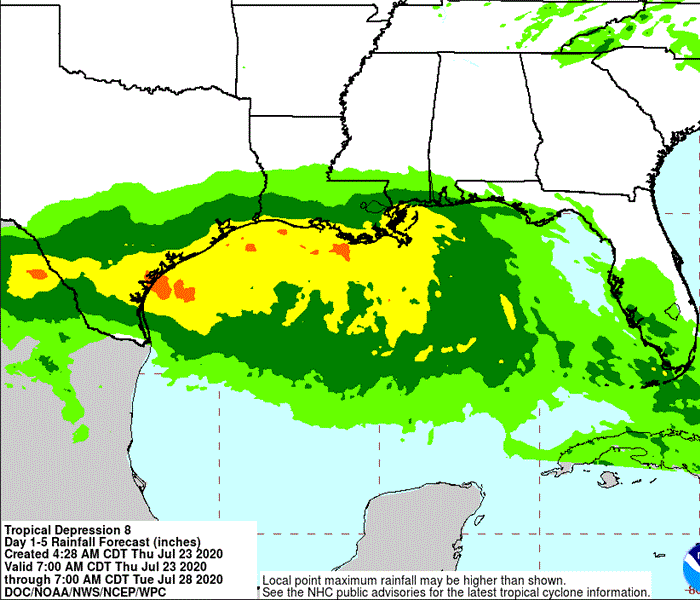 The NHC is predicting rainfall along the Texas coast.
The NHC is predicting rainfall along the Texas coast.
In our area, we are all constantly keeping our eye on the Gulf. We realize that at any time a tropical depression or storm system can quickly develop. This week we are keeping an eye on Tropical Depression Eight to see if it develops into a hurricane and what this can mean for Southeast Texas.
According to the National Hurricane Center, a tropical depression has wind speed less than 39 MPH. The NHC has issued some key messages regarding this depression. It is expected to strengthen and could bring tropical-storm-force winds to portions of the Texas coast. It is also expected to produce heavy rains across portions of Louisiana and Southern Texas. These rains could result in flash flooding.
Remember in the event of flooding while driving, its always best to turn around and not drown.
Stay safe Southeast Texas!
Flood Safety Tips
6/23/2020 (Permalink)
Each year, more deaths occur due to flooding than any other hazard related to thunderstorms. The most common flood deaths occur when a vehicle is driven into hazardous floodwater.
Here are some steps you can take to prepare for a flood:
During a Flood Watch or Warning:
- Gather emergency supplies
- Listen to local radio or television station for updates
- Have immunization records handy (store immunization records in a waterproof container)
- Prepare an emergency food and water supply. Store at least 1 gallon of water per day for each person and each pet. It is important to store at least a 3-day supply.
- Bring in outdoor possessions (lawn furniture, grills, trash cans) or tie them down securely.
- If evacuation becomes necessary: turn off all utilities at the main power switch and close the main gas valve.
- Leave areas subject to flooding: low spots, canyons, washes, etc.
After Flooding Occurs:
- Avoid driving through flooded areas and standing water.
- Do not drink flood water or use it to wash dishes, brush teeth, or wash/prepare food.
- If you evacuated: return to your home only after local authorities to find out if your water is safe for drinking and bathing.
- When in doubt, throw it out! Throw away any food and bottled water that comes/may have come in contact with floodwater.
- Prevent carbon monoxide (CO) poisoning. Use generators at least 20 ft from any doors, windows, or vents.
Disaster Recovery Team
6/10/2020 (Permalink)
SERVPRO has answered the call to help in storm situations. We have developed a specialized storm and large response network to provide the resources needed in the event of a disaster. With an unmatched national footprint of over 1,500 franchises, SERVPRO’s Storm Response can provide trained crews faster to any disaster and can be on-site within a few hours to help reduce the future damage that water can cause. SERVPRO Disaster Recovery Team has the right equipment, procedures and training to help ensure the structure is dry the first time, saving you time and money. Ultimately, our goal is to restore first and replace only when necessary and helps limit the time your property is inconvenienced. Regardless of the size of the disaster, you want results for your business or your property.
Hurricane Watch vs. Warning
6/5/2020 (Permalink)
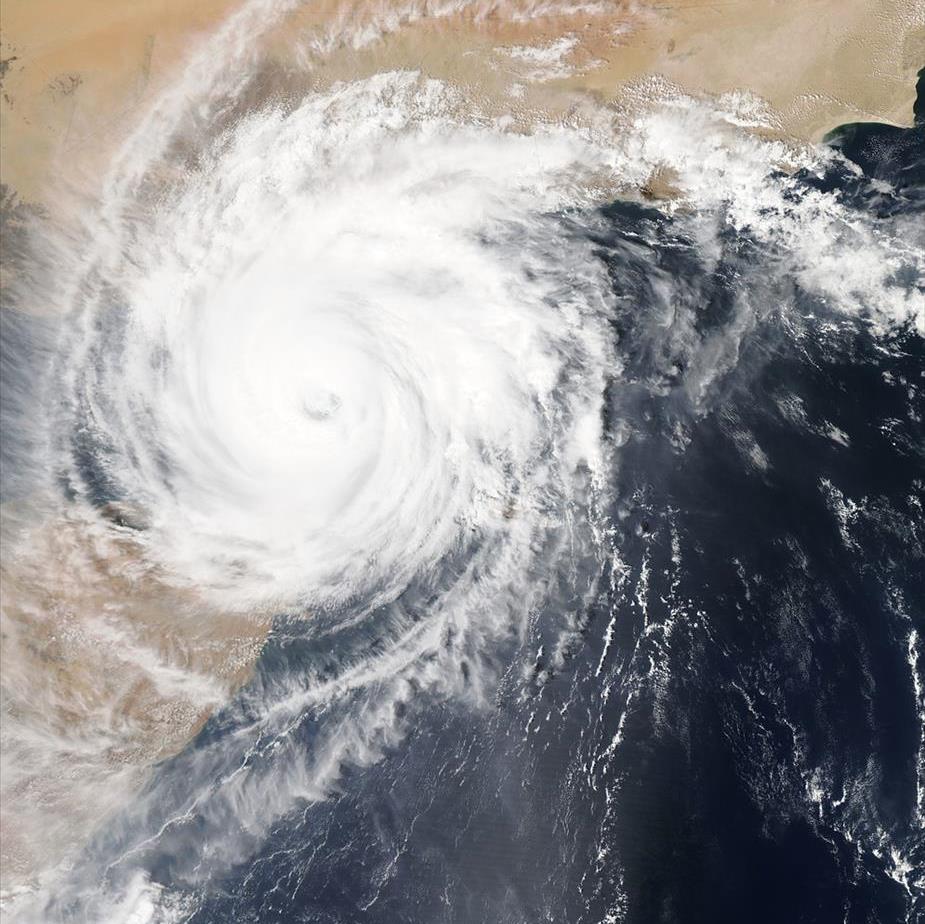 Hurricanes can cause devastating damage if you are not prepared.
Hurricanes can cause devastating damage if you are not prepared.
It is important to know the difference between a hurricane “watch” and “warning.” The National Weather Service has alerts on TV, radio, and online in the event of a hurricane.
- A hurricane watch means hurricane conditions (sustained winds of 74 mph or higher) are possible in a stated area. Experts announce hurricane watches 48 hours before they expect tropical-storm-force winds (sustained winds of 39 to 73 mph) to start.
- A hurricane warning is more serious. It means that hurricane forced winds are expected in a stated area. Experts issue these warnings 36 hours before tropical-storm-force winds are expected in the area to give people enough time to prepare for the storm.
For more information about hurricane watches and warnings. Check out the National Weather Service’s Hurricane Center.
Be Informed
3/17/2020 (Permalink)
It is important to learn the types of disasters or emergencies that may likely occur in our area. These events can range from affecting only you and your family, like a home fire or medical emergency, to those affecting your entire community like a hurricane or flood.
- Identify how local authorities will notify you during a disaster and how you will get information, whether through local radio, TV or NOAA Weather Radio stations or channels.
- Know the difference between weather alerts such as watches and warnings and what actions to take in each.
- Know what actions to take to protect yourself during disasters that may occur in areas where you travel or have moved recently. For example, if you travel to a place where earthquakes are common and you are not familiar with them, make sure you know what to do to protect yourself should one occur.
- When a major disaster occurs, your community can change in an instant. Loved ones may be hurt and emergency response is likely to be delayed. Make sure that at least one member of your household is trained in first aid and CPR and knows how to use an automated external defibrillator (AED).
Prepare for a Flood
9/11/2019 (Permalink)
Things to know & do before a flood:
- Reduce the risk of damage from flooding by elevating critical utilities, such as electrical panels, switches, sockets, wiring, appliances and heating systems.
- In areas with repetitive flooding, considering elevating the entire structure.
- Make sure basements are waterproofed and your sump pump is working. Then, install a battery-operated backup in case of power failure.
- Installing a water alarm will also let you know if water is accumulating in your basement.
- Clear debris from gutters and downspouts.
- Anchor any fuel tanks.
- Move furniture, valuables and important documents to a safe place.
- Store copies of irreplaceable documents (such as birth certificates, passports, etc.) in a safe, dry place. Keep originals in a safe deposit box.
- Build an emergency supply kit. Food, bottled water, first aid supplies, medicines and a battery-operated radio should be ready to go when you are.
- Plan and practice a flood evacuation route. Ask someone out of state to be your “family contact” in an emergency, and make sure everyone knows the contact’s address and phone number.
- Make a pet plan. Many shelters do not allow pers. Make plans now on what to do with your pets if you are required to evacuate your residence.
Source: https://www.floodsmart.gov/flood/first-prepare-for-flooding
Preparing for a Flood
7/26/2019 (Permalink)
Flooding can happen fast in many environments. The American Red Cross recommends having the following list of items packed and ready to go in the event of an evacuation due to flooding.
- Water—3+ day supply; one gallon per person per day
- Food—3+ day supply of non-perishable, easy to prepare food
- Flashlight
- Battery powered radio
- Extra batteries
- First Aid Kit
- Medications (7-day supply) and medical items
- Multi-purpose tool
- Sanitation/personal hygiene items
- Copies of personal documents
- Cell phones with chargers
- Family & Emergency contact information
- Extra Cash
- Emergency blanket
- Map(s) of the area
- Baby supplies (bottles, formula, baby food, diapers, etc.)
- Pet supplies
- Tools/supplies for securing your home
- Extra set of car keys & house keys
- Extra clothing, hat and sturdy shoes
- Rain gear
- Insect repellent and sunscreen
- Camera for photos of damage
Be Flood Smart
6/25/2019 (Permalink)
Floods are one of the most common and widespread natural disasters in the United States. Whether your home or business is near a coastline, along city streets, in the mountains, near a river or even in the desert-there is always the potential for flood damage. Floodsmart.gov reports, in the last five years, all 50 states have experienced floods or flash floods.
According to the American Red Cross (ARC), floods cause more damage in the U.S. every year that any other weather-related disaster. The ARC offers the following flood safety tips:
- Stay away from floodwaters. If you come up on a flowing stream where water is above your ankles, stop, turn around and go another way. Six inches of swiftly moving water can sweet you off of your feet.
- If you approach a flooded road while driving, turn around and go another way. If you are caught on a flooded road and waters are rising rapidly around you, get out of the car and quickly move to higher ground. Most cars can be swept away by less than two feet of moving water.
- Keep children out of the water. They are curious and often lack judgment about running water or contaminated water.
If a flood does strike your home or business, contact the SERVPRO of Beaumont/Orange/Nederland/Lumberton!
Even minor floods have the potential to cause major damage to a structure when not treated quickly and properly, and the cleanup is often an overwhelming task. The SERVPRO system is prepared to handle any size disaster.
Facts about Lightning
5/31/2019 (Permalink)
Lightning is one of the leading causes of weather-related fatalities. Though the odds of being struck by lightning in a given year are only around 1 in 500,000, some factors can put you at greater risk for being struck.
Here are a few lightning safety tips:
- Be aware. Check the forecast before participating in outdoor activities. If it calls for thunderstorms, postpone your trip or activity, or make sure adequate safe shelter is available.
- Go indoors. Remember the phrase, “When thunder roars, go indoors.” Find a safe enclosed shelter when you hear thunder. Safe shelters include homes, offices, shopping centers, and hard-top vehicles with the windows rolled up.
- Avoid windows, doors, porches and concrete. Do not lie on concrete floors and avoid leaning on concrete walls. Lighting can travel through any metal wires or bars in concrete walls or flooring.
- Avoid water. Do not bathe, shower, wash dishes, or have any other contact with water during a thunderstorm because lightning can travel through a building’s plumbing.
2019 Hurricane Season
5/30/2019 (Permalink)
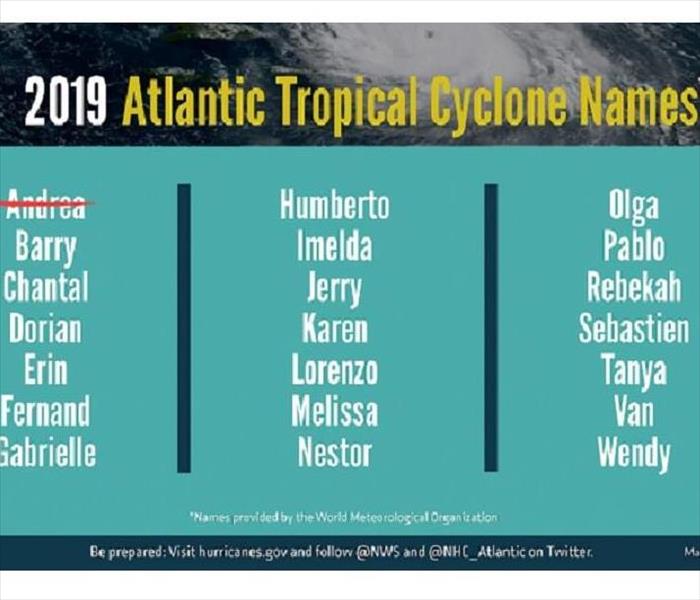 Did your name make this years' list?
Did your name make this years' list?
As many of you know the 2019 Hurricane Season starts this weekend on June 1st. The National Oceanic and Atmospheric Administration (NOAA) is predicting a near normal Atlantic hurricane season. They are predicting a likely range of 9-15 names storms and out of those storms 4-8 could become a hurricane. The NOAA is using cutting edge tools to help secure Americans against the threats that are posed by hurricanes and tropical storms. The NOAA factors in the current climate and the ongoing El Nino. The NOAA are doing all that they can to ensure that they are creating a more Weather-Ready Nation by providing the public with the information needed to take actions before, during and after a hurricane.
Source: www.noaa.gov
In the event of a hurricane the SERVPRO of Beaumont is here to help 24/7!
Disaster Recovery Team
3/13/2019 (Permalink)
Did you know that SERVPRO has a specialized storm team and large loss response network to provide the resources to your property when others can’t? In the event of a disaster, SERVPRO professionals have the resources to relocate crews with equipment to take care of all of our customer’s needs. SERVPRO strategically places mobilization teams across the country to travel when needed to support in recovery after large storm events such as hurricanes. Our job as water damage restoration professionals is to limit the amount of business interruption. We understand that fast mitigation is key to getting your business back up and running. SERVPRO provides the resources in the event of a large storm event to make sure that the right equipment, procedures and training are in place to ensure that the structure is dry the first time and saves you time and money.
Do you have questions about how SERVPRO of Beaumont can help you prepare for a disaster? Contact us today at (409) 212-1977!
Preparing for a Flood
9/10/2018 (Permalink)
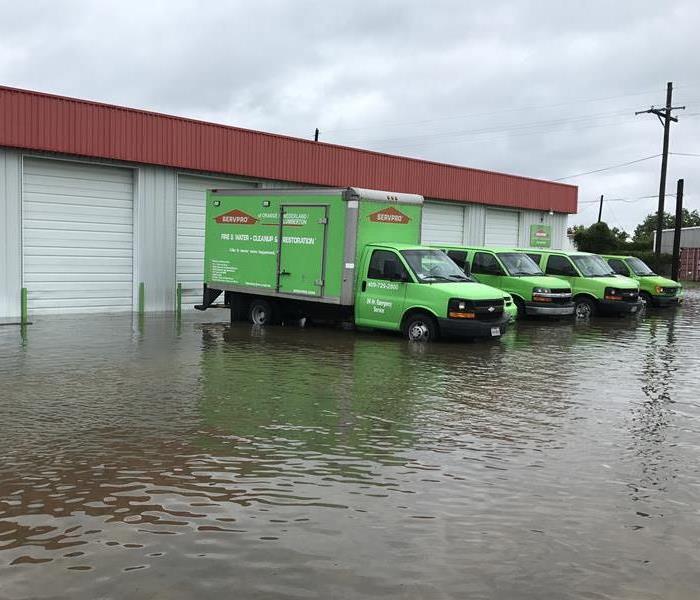 Flooding at our office after Hurricane Harvey.
Flooding at our office after Hurricane Harvey.
- Know the types of flood risk in your area. Visit FEMA’s Flood Map Service Center for more information
- Sign up for your community’s warning system. The Emergency Alert System (EAS) and National Oceanic and Atmospheric Administration (NOAA) Weather Radio also provide emergency alerts.
- If flash flooding is a risk in your location, then monitor potential signs, such as heavy rains.
- Learn and Practice evacuation routes, shelter plans, and flash flood response.
- Gather supplies in case you have to leave immediately, or if services are cut off. Keep in mind each person’s specific needs, including medication. Don’t forget the needs of your pets as well. Obtain extra batteries and charging devices for phones and other critical equipment.
- Purchase or renew a flood insurance policy. It typically takes up to 30 days for a policy to go into effect and can protect the life you’ve built. Homeowner’s policies do not cover flooding.
- Keep important documents in a waterproof container. Create password-protected digital copies.
- Protect your property. Move valuables to higher levels. Declutter drains and gutters. Install check valves. Consider a sump pump with a battery.
For more information on how to stay safe when a flood threatens, visit www.ready.gov/floods.
Hurricane Season Is Here
7/25/2018 (Permalink)
It may seem early, but hurricane season is currently underway. For the Atlantic, the season begins June 1st and runs through November 30th. The Eastern Pacific hurricane season began in mid-May and will continue through November 30th as well. Hurricanes can be life-threatening as well as cause serious property-threatening hazards such as flooding, storm surge, high winds, and tornadoes. While the primary threat is in the coastal areas, many inland areas can also be affected by these hazards, as well as by secondary events such as power outages as a result of the high winds and landslides due to rainfall.
Preparation is the best protection against the dangers of a hurricane. Plan an evacuation route and your emergency plan, take inventory of your property, and take steps to protect your home or business. For more information and preparation tips, visit the Ready campaign website at www.ready.gov/hurricanes.
2018 Hurricane Season
5/25/2018 (Permalink)
The National Oceanic and Atmospheric Administration is predicting a near or above normal 2018 Atlantic hurricane season. They’re predicting anywhere from 10-16 named storms. In the range of 5-9 becoming hurricanes and out of those 1-4 becoming major hurricanes. The NOAA states that the possibility of a weak El Nino developing and near-average sea surface temperatures across the tropical Atlantic Ocean and Caribbean Sea are two of the factors that are driving this outlook.
With all of the sophisticated technology, next-generation models and satellite data; this helps decision makers and the general public the ability to take action before, during and after hurricanes. After the 2017 Hurricane season, specifically Hurricane Harvey, Southeast Texas can use this information to be better prepared for the upcoming 2018 season.
Source: www.noaa.gov
Being Prepared
5/10/2018 (Permalink)
April showers bring May flowers! May is always a very busy month as school is coming to an end and summer is just around the corner. And before we know it we will be back to Hurricane Season!
The same is true for preparedness planning in May. The following preparedness events take place this month and offer a great chance to educate yourself!
- Wildfire Community Preparedness Day (May 5, 2018)
- National Hurricane Preparedness Week (May 6-12, 2018)
- National Dam Safety Awareness Day (May 31, 2018)
- National Building Safety Month
May also brings two weeks to show appreciation for our first responders.
- National Police Week (May 13-19, 2018)
- National Emergency Medical Services (EMS) Week (May 20-26, 2018)
Be sure to visit ready.gov for more information and resources to be prepared!
FEMA App
4/4/2018 (Permalink)
Be prepared to weather the storm with the FEMA App. This app allows you to get National Weather Service alerts for up to five locations to keep you informed on-the-go. It also has information on what to do before, during, and after different disasters. In the midst of an emergency, the app can give you directions to open shelters nearby, help you locate someone to talk to at a Disaster Recovery Center, and let you share images of damage and recovery efforts to help first responders and emergency managers.
This app is available to download for free for iOS and Android at the Apple Store and on Google Play.
Have other questions on how to prepare for a storm? Contact SERVPRO of Beaumont (409) 212-1977 on how to plan for an emergency!
Source: www.fema.gov/mobile-app
SERVPRO Disaster Recovery Team
3/12/2018 (Permalink)
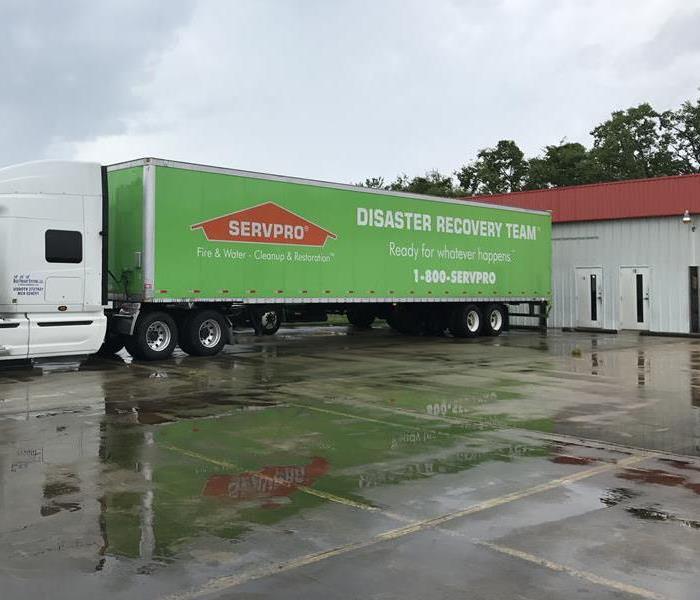 SERVPRO Disaster Recovery Team stationed at our office during Hurricane Harvey.
SERVPRO Disaster Recovery Team stationed at our office during Hurricane Harvey.
Did you know that SERVPRO has a specialized storm team and large loss response network to provide the resources to your property when others can’t? In the event of a disaster, SERVPRO professionals have the resources to relocate crews with equipment to take care of all of our customer’s needs. SERVPRO strategically places mobilization teams across the country to travel when needed to support in recovery after large storm events such as hurricanes. Our job as water damage restoration professionals is to limit the amount of business interruption. We understand that fast mitigation is key to getting your business back up and running. SERVPRO provides the resources in the event of a large storm event to make sure that the right equipment, procedures and training are in place to ensure that the structure is dry the first time and saves you time and money.
Do you have questions about how SERVPRO of Beaumont can help you prepare for a disaster? Contact us today at (409) 212-1977!
SERVPRO ERP Advantage
3/1/2018 (Permalink)
Do you own a business or businesses? In Southeast Texas, we know we can’t prevent disasters from happening, but we can prepare for them. What if I told you SERVPRO of Beaumont could help provide peace of mind to your businesses in the event of a disaster? With an Emergency Ready Profile (ERP), you can prepare your business and minimize work interruption by creating an immediate plan of action in the event of a disaster. An ERP is at no cost to you and/or your business. It places all important information in a smart phone app at the palm of your hand. It also provides shut-off valve locations, priority areas and priority contact information—creating a quick reference of what to do, how to do it and who to contact in the event of a disaster. Finally, it establishes SERVPRO of Beaumont as your local disaster mitigation and restoration provider.
Contact us today (409) 212-1977 for your no cost assessment of you facility preparing you for the next disaster!
Severe Weather Safety
2/20/2018 (Permalink)
Severe weather can happen at any time, anywhere. Each year, Americans cope with an average of the following intense storms:
- 10,000 severe thunderstorms
- 5,000 floods or flash floods
- 1,300 tornadoes
- 2 land falling deadly hurricanes
Knowing your risk of severe weather, taking action, and being an example are just a few steps you can take to be better prepared to save your life and assist in saving the lives of others.
Know Your Risk. The first step to becoming weather-ready is to understand the type of hazardous weather that can affect where you live and work, and how the weather could impact you, your business and your family. Check the weather forecast regularly, obtain NOAA Weather Radio, and learn about Wireless Emergency Alerts. Severe weather comes in many forms, and your shelter plan should include all types of local hazards.
Take Action. Take the next step in severe weather preparedness by creating a communications plan for your home and business. Keep important papers and valuables in a safe place.
Be an Example. Once you have taken action to prepare for a severe weather, share your story with co-workers, family, and friends on Facebook or Twitter. Your preparedness story will inspire others to do the same.
Hurricane Harvey
2/14/2018 (Permalink)
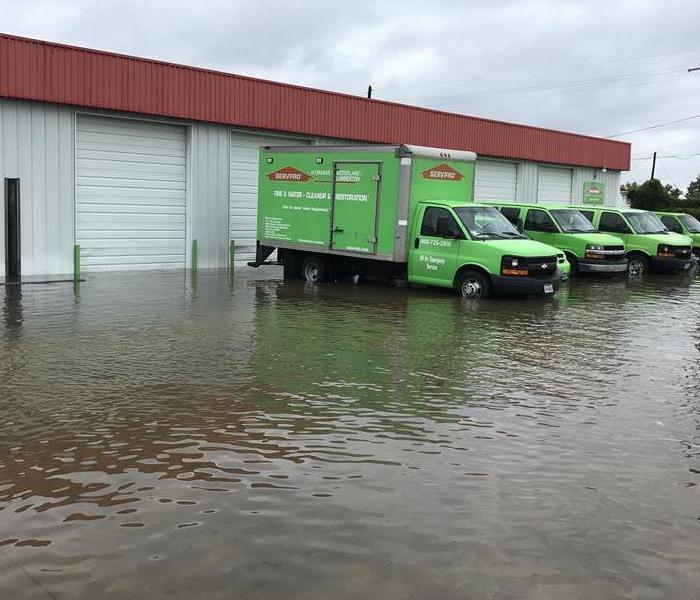 Our flooded office due to Hurricane Harvey.
Our flooded office due to Hurricane Harvey.
Here we are 6 months after the biggest storm event our community has endured in the many years. Hurricane Harvey affected our SERVPRO office in many ways. Our office flooded alongside with the rest of Southeast Texas. Our SERVPRO team strived to service as many of the affected community members as possible. With the help of our SERVPRO Storm Team, we were able to touch so many of those affected during this disastrous event. It has been truly amazing to see Southeast Texas come together; as many experienced loss on such a significant scale. Southeast Texas has done a wonderful job restoring the community and help place a sense of normalcy for our area. Our SERVPRO family is blessed to be a part of such a strong and united community!
Ready for whatever happens, SERVPRO Storm Team
10/4/2016 (Permalink)
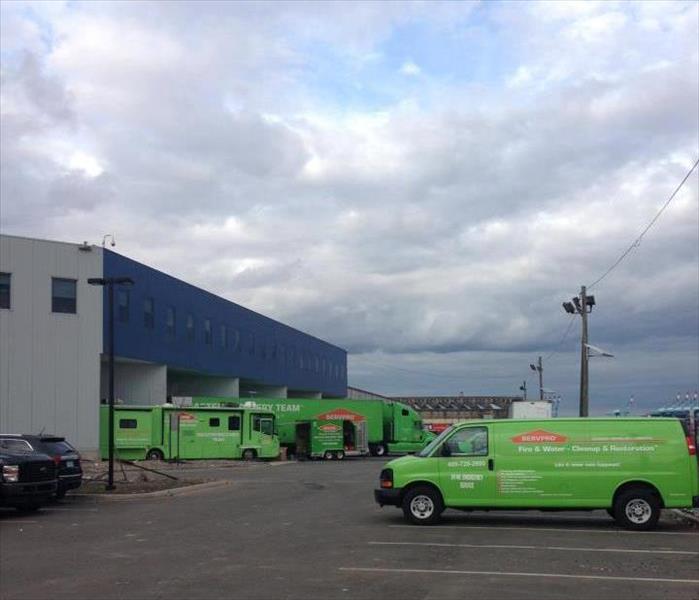 SERVPRO of Beaumont, in Elizabethtown, New Jersey helping with the clean up efforts after 2012 Hurricane Sandy.
SERVPRO of Beaumont, in Elizabethtown, New Jersey helping with the clean up efforts after 2012 Hurricane Sandy.
Ready For Whatever Happens
SERVPRO Storm
When a storm or disaster strikes, SERVPRO’s Disaster Recovery Team is poised and “Ready for whatever happens.” With a network of more than 1,700 Franchises, the SERVPRO System strives to be faster to any size disaster. Strategically located throughout the United States, SERVPRO’s Disaster Recovery Team, is trained and equipped to handle the largest storms and highest flood waters. Providing experience, manpower, equipment and other resources, the Disaster Recovery Team assists your local SERVPRO Franchise Professionals. SERVPRO’s Disaster Recovery Team has responded to hundreds of disaster events. In the aftermath of a disaster, there is only one objective, to help you make it “Like it never even happened.”
- 2016 Houston, TX Flooding- In April, a nearly stationary mesoscale convective system developed over Houston resulting in widespread rainfall rates of 2-4 inches per hour. This was a historic flooding event for Harris County which saw a total of nearly 18 inches per hour. The Storm Team dispatched 81 crews to over 360 jobs mitigation over $3 million in damages.
- 2015 Siberian Express: Record sub-zero temperatures caused major problems for a large portion of the country stretching from Florida to Maine. The Midwest also experienced record breaking low temperature3s resulting in frozen pipes and ice dams causing major problems for residents. The Strom Team dispatched a total of 257 crews from 108 Franchises to assist local SERVPRO Franchises completing nearly 2000 jobs.
- 2014 Mid-Atlantic Flooding: Rainfall rates up to 2 inches per hour caused major flash flooding stretching from Northeast Ohio all the way up to Portland, Maine. Eastern Michigan and Baltimore, Maryland were also impacted creating over 1381 jobs for the Strom team to produce. A total of 82 SERVPRO Franchises and 173 crews mitigated over $4.3 million in damages while assisting the local Franchises.
- 2014 Polar Vortex: Record low temperatures caused by a break in the North Pole’s polar vortex resulted in an unprecedented freezing event, spanning from east of the Rocky Mountains to as far south as Central Florida, effecting all or part of 39 states and 70 % of the SERVPRO Franchise System.
- 2013 Colorado Floods: Heavy rainfall, with amounts up to 17 inches in some areas, resulted in the widespread flooding in Fort Collins, Boulder and surrounding Colorado mountain communities. The Disaster Recovery Team responded with 109 crews and 48 Franchises to assist the local SERVPRO Franchises in the emergency response.
- 2012 Hurricane Sandy: Affecting more than 20 states, Sandy left widespread damage and flooding from Florida stretching the entire eastern seaboard to Maine. The Disaster Recovery Team placed nearly 1000 crews in affected areas, representing over 300 SERVPRO Franchises from across the country. Teams traveled from as far as Arizona, California, Oregon and Washington.
Flooding is never nice
4/22/2016 (Permalink)
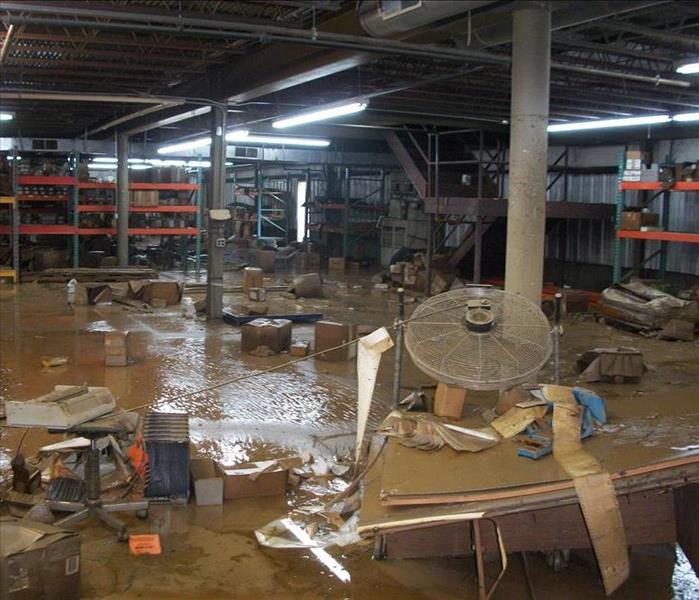 This is a picture of a commercial flood loss SERVPRO of Beaumont helped get back on their feet and back into business.
This is a picture of a commercial flood loss SERVPRO of Beaumont helped get back on their feet and back into business.
Whether you live on the coast, near a lake, or riverside, the flood will find you. And when it does, it can leave you with years’ worth of damage, not to mention credit card bills and bankruptcy.
Various news stories of commercial and residential properties drowning in murky waters, or sitting empty a year later look abandoned and still reeking with ‘remnants of saturated insulation and mold hanging from the beams’ as one homeowner described it…will inject fear into anyone’s heart.
For that reason, the Federal Emergency Management Agency (hhtp://www.fema.gov/) (FEMA) has published a guide stating which materials are best used in certain situations.
It’s interesting because even safe materials, when combined with unsafe products such as adhesives, become undesirable. For instance, vinyl tile is an acceptable surface but if it’s applied over plywood it becomes unacceptable because there’s no way for the plywood to dry after a flood. Even oil-based paint can inhibit drying of a wooden wall.
That’s when you call the professionals at SERVPRO® of Beaumont, to make sure the situation is handled so there are no surprises and no adverse effects on the occupants’ health or safety.
SERVPRO® Cleans Up the Mess after a Flood
FEMA says the following are not permitted in flood-prone areas:
· Normal adhesives which are water soluble or not resistant to alkali or acid in water
· Materials containing wood or paper products, or other materials that lose structural integrity when exposed to water
· Sheet-type floor or wall coverings (linoleum, rubber tile, wallpaper) that inhibit drying of the materials they cover
· Materials that are ‘dimensionally unstable’-for instance, a door jamb that swells and does not return to its original size
· Materials that retain excessive water after they’ve been submerged.
We have so much more to lose…
Homeowners tell us there is no greater devastation than seeing the house they’ve made a home destroyed by a quick-moving flood. The fact that the flood could have been caused by something as innocuous as a leaking pipe behind the washing machine makes the destruction seem even more senseless.
FEMA’s classification was based on the fact that a home constructed with the vulnerable materials may harbor mold, other fungi or allergens; that materials may absorb chemicals and continue to exude them even after the house has been thoroughly dried. In addition, water renders some materials more susceptible to rot. These are just a few of the many aftereffects of a flood.
SERVPRO® of Beaumont Should Be On Speed-Dial
The SERVPRO® of Beaumont team has been trained to respond, swiftly and knowledgably. There’s a reason why FEMA and the EPA recommend consulting with professionals in the wake of water damage.
Back in the day (as they say), houses were made of straw, stone, or brick. If they weren’t blown down or burned up, they were abandoned by the time the children were grown. Today, the American home is our castle. It reflects our lives, interests, and loves, travels, hopes, memories and the most important people we share it with.
Let’s hope you are not victim of a home-destroying event. But if it happens, don’t panic. Keep our number handy: 409.212-1977. We’re here 24/7 to answer the call…and make your loss Like It Never Even Happened.




 24/7 Emergency Service
24/7 Emergency Service



